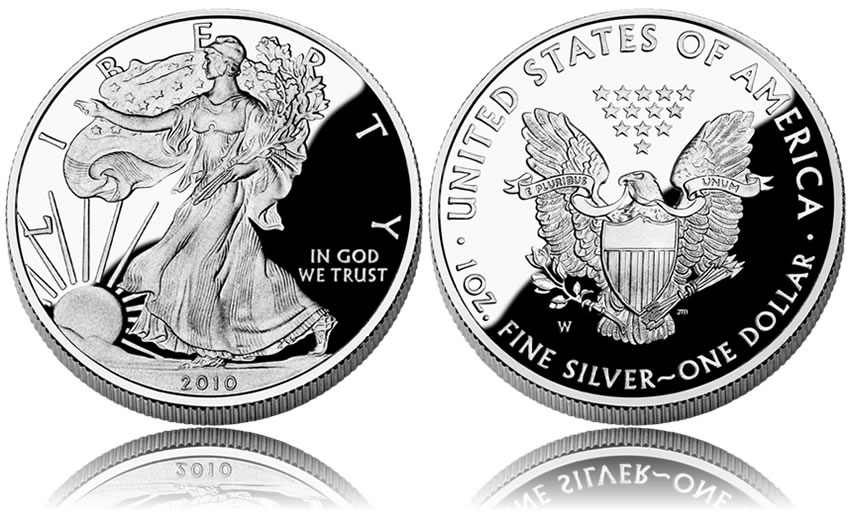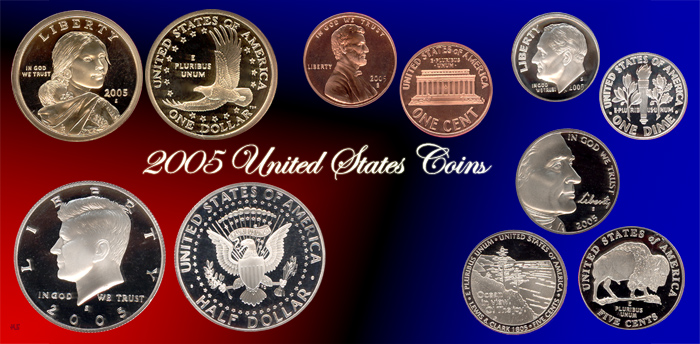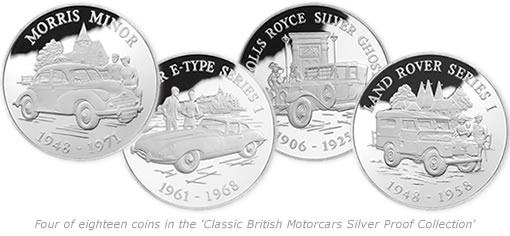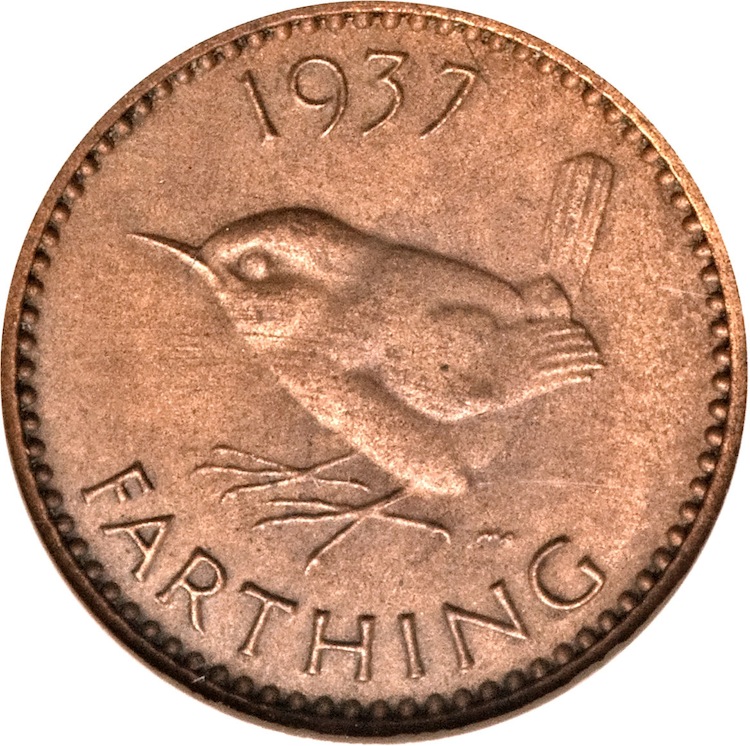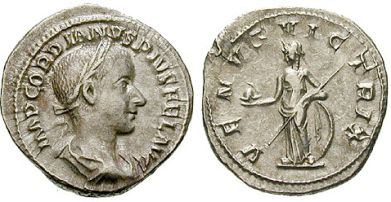Proof Coins
The term “proof” refers to a manufacturing process that results in a special surface or finish on coins made for collectors. Most familiar are modern brilliant proofs. These coins are struck at the Mint by a special process. Carefully prepared dies, sharp in all features are made. Then the flat surfaces of the dies are given a high, mirror-like polish. Specially prepared planchets are fed into low-speed coining presses. Each proof coin is slowly and carefully struck more than once to accentuate details. When striking is completed, the coin is taken from the dies with care and not allowed to come into contact with other pieces. The result is a coin with a mirror like surface. The piece is then grouped together with other denominations in a set and offered for sale to collectors.
From 1817 through 1857, proof coins were made only on special occasions and not for general sale to collectors. They were made available to visiting foreign dignitaries, government officials, and those with connections at the Mint. Earlier (pre-1817) U.S. coins may have proof-like surfaces and many proof characteristics (1796 silver coins are good examples), but they were not specifically or intentionally struck as proofs. These are sometimes designated as “specimen strikings.”
Beginning in 1858, proofs were sold to collectors openly. In that year, 80 silver proof sets (containing silver coins from the three-cent through the dollar), plus additional pieces of the silver-dollar denomination, were produced, as well as perhaps 200 (the exact number is not known) copper-nickel cents and a limited number of proof gold coins.
The traditional, or “brilliant,” type of proof finish was used on all American proof coins of the 19th century. During the 20th century, cents through the 1909 Indian type, nickels through the 1912 Liberty, regular-issue silver coins through 1915, and gold coins through 1907 were of the brilliant type. When modern proof coinage was resumed in 1936 and continued through 1942, then 1950-1964, and 1968 to date, the brilliant finish was used. These types of proofs are referred to as “brilliant proofs,” actual specimens may have toned over the years. The mirror-like surface is still evident, however.
From 1908 through 1915, matte proofs and sandblast proofs (the latter made by directing fine sand particles at high pressure toward the coin’s surface) were made of certain coins (exceptions are the 1909-1910 proofs with Roman finish).
Characteristics vary from issue to issue, but generally all of these pieces have extreme sharpness of design detail and sharp, squared-off rims. The surfaces are without luster and have a dullish matte surface. Sandblast proofs were made of certain commemoratives also, such as the 1928 Hawaiian issue.
Roman-finish proof gold coins were made in 1909 and 1910. These pieces are sharply struck and have squared-off edges and a satin-like surface finish, not too much different from an uncirculated coin (which causes confusion among collectors today and which, at the time of issue, was quite unpopular because collectors resented having to pay a premium for a coin without a distinctly different appearance).
Matte proofs were made of 1908-1917 Lincoln cents and 1913-1917 Buffalo nickels. Such coins have extremely sharp design detail, squared-off rims, and “brilliant” (mirror-like) edges, but a matte or satin-like (or even satin surface, not with flashy mint luster) surface. In some instances matte-proof dies may have been used to make regular circulation strikes once the requisite number of matte proofs were made for collectors. So it is important that a matte proof, to be considered authentic, have squared-off rims and mirror-like perfect edges in addition to the proper surface characteristics.
Additional Points Concerning Proofs
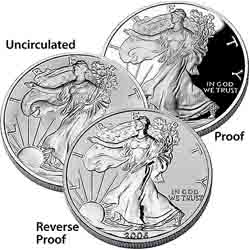 Certain regular issues, or business strikes, have nearly full proof-like surfaces. These were produced in several ways. Usually regular-issue dies (intended to make coins for circulation) were polished to remove surface marks or defects for extended use. Coins struck from these dies were produced at high speed, and the full proof surface is not always evident. Also, the pieces are struck on ordinary planchets. Usually such pieces, sometimes called “first strikes” or “proof-like uncirculated,” have patches of uncirculated mint frost. A characteristic in this regard is the shield on the reverse (on coins with this design feature). The stripes within the shield on proofs are fully brilliant, but on proof-like non-proofs the stripes usually are not mirror-like. Also, the striking may by weak in areas and the rims might not be sharp.
Certain regular issues, or business strikes, have nearly full proof-like surfaces. These were produced in several ways. Usually regular-issue dies (intended to make coins for circulation) were polished to remove surface marks or defects for extended use. Coins struck from these dies were produced at high speed, and the full proof surface is not always evident. Also, the pieces are struck on ordinary planchets. Usually such pieces, sometimes called “first strikes” or “proof-like uncirculated,” have patches of uncirculated mint frost. A characteristic in this regard is the shield on the reverse (on coins with this design feature). The stripes within the shield on proofs are fully brilliant, but on proof-like non-proofs the stripes usually are not mirror-like. Also, the striking may by weak in areas and the rims might not be sharp.
The mirror-like surface of a brilliant proof coin is much more susceptible to damage than the surfaces of an uncirculated coin. For this reason, proof coins that have been cleaned often show a series of fine hairlines or minute striations. Also, careless handling has resulted in certain proofs acquiring marks, nicks, and scratches. Some proofs, particularly 19th-century issues, have “lint marks.” When a proof die was wiped with an oily rag, sometimes threads, bits of hair, lint and so on would remain. When a coin was struck from such a die, an incuse or recess impression of the debris would appear on the piece. Lint marks visible to the unaided eye should be specially mentioned in a description.
Proofs are divided into the following classifications:
Proof-70. A proof-70, or “perfect proof,” has no hairlines, handling marks, or other defects; in other words, a flawless coin. Such a coin may be brilliant or may have natural toning.
Proof-67. A grade midway between proof-70 and proof-65 and would be noticeably finer than proof-65.
Proof-65. Proof-65, or “choice proof,” refers to a proof that may show some very fine hairlines, usually from friction-type cleaning or friction-type drying or rubbing after dipping. To the unaided eye, a proof-65 will appear to be virtually perfect. However, 4X magnification will reveal some minute lines. Such hairlines are best seen under strong incandescent light.
Proof-63. A coin midway between proof-65 and proof-60.
Proof-60. A coin with some scattered handling marks and hairlines visible to the unaided eye.
Impaired Proofs: Other Comments
If a proof has been excessively cleaned, has many marks, scratches, dents, or other defects, it is described as an impaired proof. If the coin has seen extensive wear, then it will be graded one of the lesser grades: proof-55, proof-45, and so on. It is not logical to describe a slightly worn proof as “AU” (“almost uncirculated) for it never was “uncirculated” in the sense that “uncirculated” describes a top-grade, normal-production strike. So the term “impaired proof” is appropriate. It is best to describe fully such a coin. Examples:
“Proof with extensive hairlines and scuffing.” “Proof with numerous nicks and scratches in the field.” “Proof-55, with light wear on the higher surfaces.”
Uncirculated Coins
The term “uncirculated,” interchangeable with “mint state,” refers to a coin that has never seen circulation. Such a piece has no wear of any kind. A coin as bright as the time it was minted or with very light natural toning can be described as “toned uncirculated.” Except for copper coins, the presence or absence of light toning does not affect an uncirculated coin’s grade. Indeed, among silver coins, attractive natural toning often results in the coin bringing a premium.
The quality of luster or “mint bloom” on an uncirculated coin is an essential element in correctly grading the piece and has a bearing on its value. Luster may in time become dull, frosty, spotted, or discolored. Unattractive luster will normally lower the grade.
Except for certain special mint sets made in recent years for collectors, uncirculated, or normal production-strike, coins were produced on high-speed presses, stored in bags together with other coins, run through counting machines, and in other ways handled without regard to numismatic posterity. As a result, it is the rule and not the exception for an uncirculated coin to have bag marks and evidence of coin-to-coin contact, although the piece might not have seen actual commercial circulation. The number of such marks will depend on the coin’s size. Differences in criteria in this regard are given in the individual sections under grading descriptions for different denominations and types.
Grading Standard Interpretations
The official ANA grading standards in the mint-state range as described have been adapted
Uncirculated coins can be divided into five major categories:
MS-70. MS-70, or perfect uncirculated, is the finest quality available. Such a coin under 4X magnification will show no bag marks, lines, or other evidence of handling or contact with other coins.
A brilliant coin may be described as “MS-70 brilliant” or “perfect brilliant uncirculated.” A lightly toned nickel or silver coin may be described as “MS-70 toned” or “perfect toned uncirculated.” Or, in the cases of particularly attractive or unusual toning, additional adjectives may be in order such as “perfect uncirculated with attractive iridescent toning around the borders.”
Copper and bronze coins: To qualify as MS-70, a copper or bronze coin must have its full luster and natural surface color, and may not be toned brown, olive, or any other color. (Coins with toned surfaces that are otherwise perfect should be described as MS-65 rather than MS-67.)
MS-67. This refers to a coin that is midway between MS-70 and MS-65. The coin may be either brilliant or toned (except for a copper coin, for which a toned piece should be described as MS-65).
MS-65. This refers to an above uncirculated coin that may be brilliant or toned (and described accordingly) and that has fewer bag marks than usual; scattered, occasional bag marks on the surface; or perhaps one or two very light rim marks. MS-63. A coin midway between MS-65 and MS-60.
MS-60. MS-60, or uncirculated (typical uncirculated without any other adjectives) refers to a coin that has a moderate number of bag marks on its surface. Also present may be a few minor edge nicks and marks, although not of a serious nature. Unusually deep bag marks, nicks, and the like must be described separately. A coin may be either brilliant or toned.

